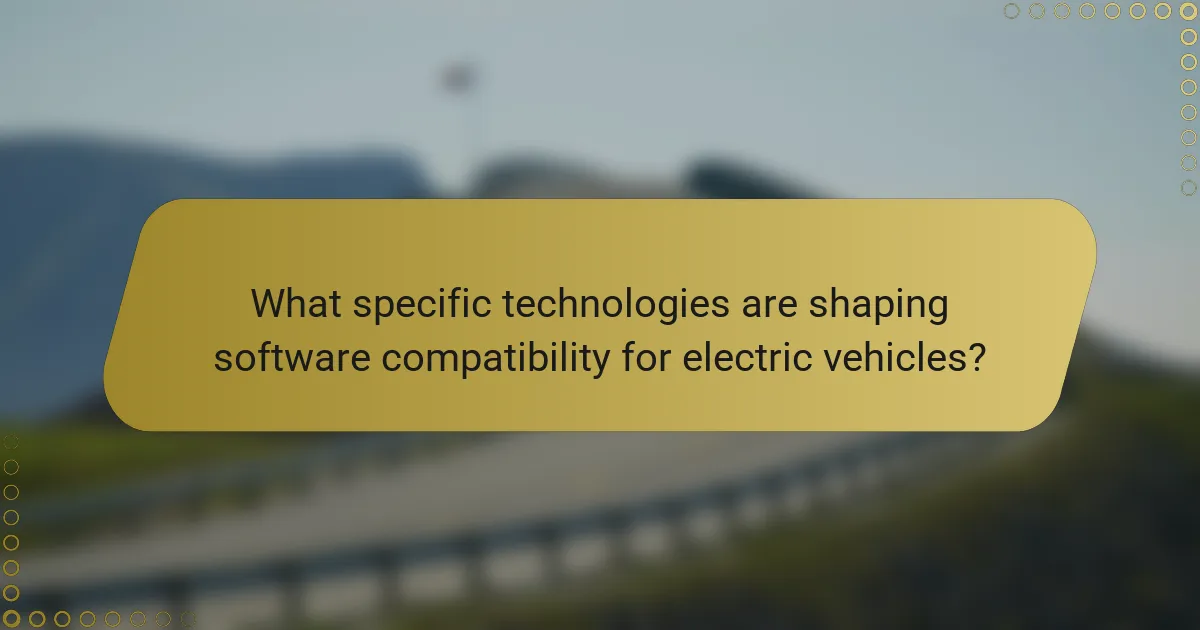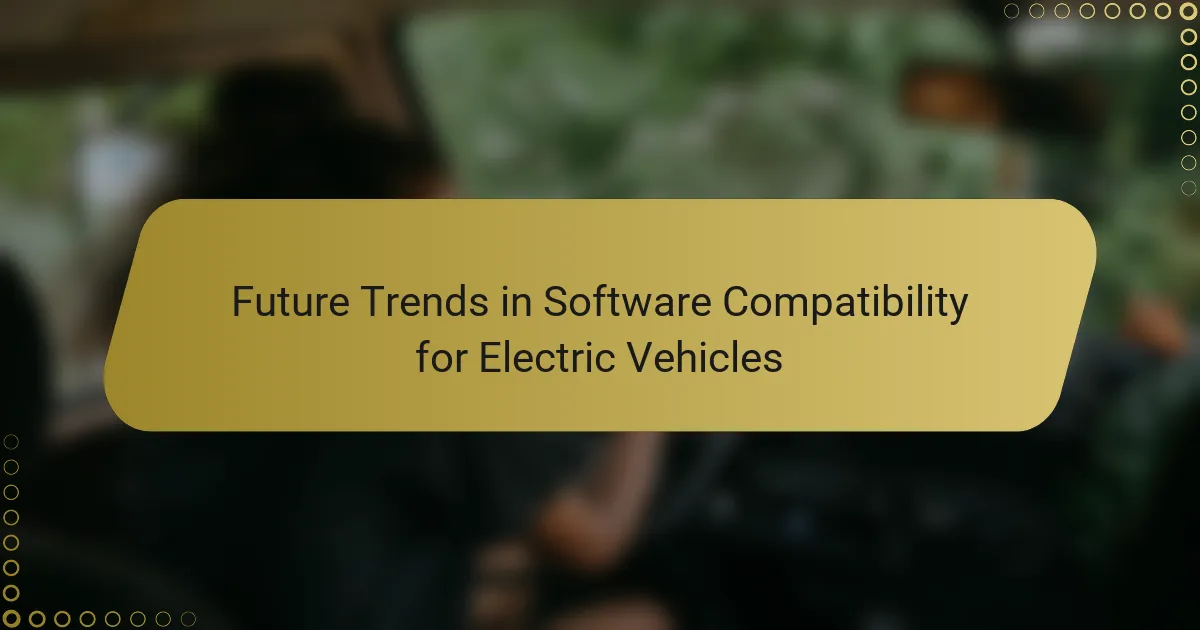The article focuses on future trends in software compatibility for electric vehicles (EVs), highlighting key developments such as increased standardization, enhanced interoperability, and the rise of over-the-air updates. Standardization aims to unify communication protocols across manufacturers, facilitating interaction between various EV models and charging stations. Enhanced interoperability will integrate third-party applications seamlessly, while over-the-air updates will allow manufacturers to remotely improve software performance and security. Additionally, the article discusses the impact of cloud computing and vehicle-to-everything (V2X) communication on EV software compatibility, emphasizing their role in enhancing vehicle performance, safety, and user experience. The trends outlined are essential for driving consumer adoption and satisfaction in the evolving EV market.

What are Future Trends in Software Compatibility for Electric Vehicles?
Future trends in software compatibility for electric vehicles (EVs) include increased standardization, enhanced interoperability, and the rise of over-the-air updates. Standardization efforts aim to unify protocols across different manufacturers. This will facilitate easier communication between various EV models and charging stations. Enhanced interoperability will allow for seamless integration of third-party applications and services. Over-the-air updates will enable manufacturers to improve software performance and security remotely. According to a report by McKinsey & Company, the global EV software market is projected to grow significantly, highlighting the importance of these trends. As EV technology evolves, software compatibility will play a critical role in consumer adoption and satisfaction.
How is software compatibility defined in the context of electric vehicles?
Software compatibility in the context of electric vehicles refers to the ability of different software systems to work together seamlessly. This includes the interaction between the vehicle’s operating system and various applications or platforms. Compatibility ensures that updates, features, and functionalities can be integrated without issues. For electric vehicles, this is crucial for optimizing performance, enhancing user experience, and maintaining safety standards. As electric vehicles increasingly rely on software for functions like battery management and autonomous driving, compatibility becomes essential for system reliability and efficiency. Research indicates that software compatibility can significantly impact the overall functionality of electric vehicles, influencing consumer satisfaction and adoption rates.
What are the key components of software compatibility in electric vehicles?
Key components of software compatibility in electric vehicles include communication protocols, operating systems, and application interfaces. Communication protocols ensure that different vehicle systems can exchange data effectively. Common protocols like CAN (Controller Area Network) facilitate real-time communication among components. Operating systems, such as Linux or Android Automotive, provide a platform for software applications to run. Application interfaces, or APIs, allow third-party developers to create compatible applications. These components must work seamlessly to ensure functionality and user experience. Compatibility testing is essential to verify that software updates do not disrupt existing systems. Additionally, adherence to industry standards enhances interoperability among various manufacturers.
Why is software compatibility critical for electric vehicle performance?
Software compatibility is critical for electric vehicle performance because it ensures seamless integration of various systems. These systems include battery management, powertrain control, and infotainment. Each component relies on software to function optimally. Incompatibilities can lead to reduced efficiency and performance issues. For example, mismatched software can cause battery management systems to miscalculate charge levels. This miscalculation can lead to reduced driving range or even battery damage. Additionally, software updates are essential for enhancing vehicle capabilities and safety. A study by the International Council on Clean Transportation highlights that software optimization can improve energy efficiency by up to 15%. Thus, software compatibility directly impacts the overall performance and reliability of electric vehicles.
What are the anticipated advancements in software compatibility for electric vehicles?
Anticipated advancements in software compatibility for electric vehicles include enhanced interoperability and improved over-the-air updates. Manufacturers are focusing on creating standardized software platforms. This will facilitate seamless integration across different vehicle brands. Increased collaboration between automakers and tech companies is expected. This collaboration aims to unify software systems for better user experience. Additionally, advancements in artificial intelligence will enable smarter vehicle software. These improvements will enhance real-time data processing and predictive maintenance. According to a report by McKinsey & Company, over 90% of new vehicles will feature advanced software capabilities by 2030.
How will artificial intelligence influence software compatibility in electric vehicles?
Artificial intelligence will enhance software compatibility in electric vehicles. AI can streamline software integration across diverse systems in electric vehicles. It allows for real-time data processing and analysis. This capability helps identify and resolve compatibility issues quickly. AI algorithms can predict potential software conflicts before they arise. This proactive approach reduces downtime and improves vehicle performance. Research shows that AI-driven systems can adapt to new software updates seamlessly. A study by the International Council on Clean Transportation indicates enhanced compatibility leads to better user experiences and increased adoption of electric vehicles.
What role will cloud computing play in enhancing software compatibility?
Cloud computing will significantly enhance software compatibility for electric vehicles. It provides a centralized platform for software updates and data management. This allows manufacturers to deploy updates across multiple vehicle models simultaneously. Real-time data sharing improves interoperability between different systems. Cloud solutions facilitate standardized APIs, enabling seamless integration of third-party applications. Enhanced collaboration among developers leads to more compatible software solutions. According to a report by McKinsey, cloud services can reduce development time by up to 30%. This efficiency fosters greater compatibility across various software systems in electric vehicles.
What challenges are faced in achieving software compatibility for electric vehicles?
Achieving software compatibility for electric vehicles faces several challenges. One major challenge is the diversity of software platforms used by different manufacturers. Each manufacturer may use unique coding languages and architectures. This creates difficulties in standardizing software across various models. Additionally, regulatory requirements vary by region, complicating compliance efforts.
Another challenge is the rapid pace of technological advancement. Software updates and new features can lead to compatibility issues with older systems. Cybersecurity concerns also play a significant role. Ensuring that software updates do not introduce vulnerabilities is critical. Furthermore, the integration of third-party applications can create additional compatibility hurdles.
Finally, the need for real-time data processing in electric vehicles adds complexity. This requires robust software that can handle large volumes of data efficiently. Overall, these challenges highlight the need for a unified approach to software development in the electric vehicle industry.
What are the common technical obstacles to software compatibility?
Common technical obstacles to software compatibility include differing programming languages, varying software architectures, and inconsistent data formats. Programming languages can limit the interoperability of software systems. For example, a system written in Java may not easily integrate with one written in Python. Varying software architectures can create challenges as well. Different systems may use distinct design patterns, which complicates integration efforts. Inconsistent data formats further hinder compatibility. Systems that utilize XML may struggle to communicate with those using JSON. Additionally, hardware dependencies can pose obstacles. Software designed for specific hardware may not perform well on different platforms. These factors collectively contribute to the difficulties in achieving seamless software compatibility.
How do regulatory standards impact software compatibility in electric vehicles?
Regulatory standards significantly influence software compatibility in electric vehicles. These standards establish requirements for interoperability, safety, and performance. Compliance with regulations ensures that different software systems can work together seamlessly. For example, the ISO 26262 standard focuses on functional safety in automotive systems. Adhering to such standards helps manufacturers avoid compatibility issues. Additionally, regulatory frameworks can drive the adoption of common communication protocols. This promotes uniformity across various electric vehicle brands. Ultimately, these standards enhance consumer trust and industry reliability.
How do current trends affect the future of software compatibility in electric vehicles?
Current trends in electric vehicle (EV) technology significantly influence future software compatibility. The rise of over-the-air (OTA) updates allows manufacturers to enhance software without physical recalls. This trend ensures that vehicles remain up-to-date with the latest features and security patches. Additionally, the integration of artificial intelligence (AI) in EVs requires standardized software platforms for seamless operation. The push for interoperability among charging stations and vehicle software is also increasing. This compatibility is essential for user convenience and broader EV adoption. Moreover, regulatory standards are evolving to mandate certain software functionalities, impacting future designs. As a result, manufacturers are prioritizing flexible and modular software architectures. These trends collectively shape a future where software compatibility is crucial for innovation and consumer satisfaction in electric vehicles.
What are the implications of open-source software on electric vehicle compatibility?
Open-source software enhances electric vehicle compatibility by promoting interoperability among different systems. It allows manufacturers and developers to access and modify the software, leading to standardized protocols. This standardization can reduce compatibility issues between various electric vehicle models and charging stations. Furthermore, open-source software encourages collaboration among developers, which can accelerate innovation in vehicle technology. For instance, projects like Open Charge Point Protocol (OCPP) aim to ensure that charging stations work with multiple vehicle brands. The increased transparency of open-source solutions can also improve security and reliability in electric vehicle software. As a result, consumers benefit from a wider range of compatible products and services.
How are automotive manufacturers adapting to changing software compatibility needs?
Automotive manufacturers are adapting to changing software compatibility needs by implementing flexible software architectures. These architectures allow for easier updates and integration of new technologies. Many manufacturers are adopting over-the-air (OTA) updates to enhance vehicle software without requiring physical service visits. This approach improves the compatibility of software with various vehicle systems.
Additionally, companies are collaborating with tech firms to develop standardized platforms. These partnerships help ensure that software can work across different vehicle models and brands. Furthermore, manufacturers are investing in cloud-based solutions for better data management and software deployment.
For instance, Tesla has successfully utilized OTA updates to enhance vehicle performance and features. This strategy demonstrates a practical application of adapting to software needs. Overall, the automotive industry is increasingly focused on creating a more adaptable software ecosystem.

What specific technologies are shaping software compatibility for electric vehicles?
Cloud computing, vehicle-to-everything (V2X) communication, and standardized software platforms are shaping software compatibility for electric vehicles. Cloud computing enables real-time data processing and updates, improving vehicle performance and user experience. V2X communication allows electric vehicles to interact with infrastructure and other vehicles, enhancing safety and efficiency. Standardized software platforms, like Android Automotive, facilitate app development and integration across different manufacturers. These technologies ensure that electric vehicles can adapt to new software applications and services seamlessly. The integration of these technologies is essential for the future of electric mobility.
How do vehicle-to-everything (V2X) communications enhance software compatibility?
Vehicle-to-everything (V2X) communications enhance software compatibility by enabling seamless data exchange between vehicles and their environment. This connectivity allows vehicles to receive real-time updates from traffic signals, road conditions, and other vehicles. Consequently, software systems can adapt dynamically to changing conditions. V2X communications facilitate the integration of various software platforms, ensuring that different manufacturers’ systems can work together. This interoperability is crucial for developing advanced driver-assistance systems and autonomous vehicles. Research indicates that V2X can improve safety and efficiency, as highlighted in the “Impact of V2X Communication on Traffic Safety and Efficiency” study by the University of Michigan. The study demonstrates that enhanced software compatibility through V2X leads to better overall vehicle performance and user experience.
What are the benefits of V2X communications for electric vehicle ecosystems?
V2X communications enhance electric vehicle ecosystems by enabling real-time data exchange between vehicles and their environment. This technology improves traffic management by allowing vehicles to communicate with traffic signals and other infrastructure. It enhances safety by providing warnings about potential hazards or accidents ahead. V2X also optimizes energy consumption by facilitating smart charging based on grid demand. Studies show that V2X can reduce traffic congestion by up to 30%. Additionally, it supports the integration of renewable energy sources by coordinating vehicle charging times with peak renewable generation. Overall, V2X communications contribute to a more efficient, safe, and sustainable electric vehicle ecosystem.
What challenges does V2X communication present for software compatibility?
V2X communication presents significant challenges for software compatibility. These challenges arise from the need for diverse systems to communicate effectively. Different manufacturers may use varying communication protocols. This inconsistency can lead to interoperability issues. Additionally, software updates across devices can create compatibility gaps. The rapid evolution of technology further complicates standardization efforts. Security concerns also necessitate unique software adaptations. These factors collectively hinder seamless integration of V2X communication in electric vehicles.
What innovations in software architecture are influencing compatibility?
Microservices architecture is a significant innovation influencing compatibility in software design. This approach allows for the development of small, independent services that communicate over APIs. Each service can be updated or replaced without affecting the entire system. This modularity enhances compatibility across different platforms and technologies. Containerization technologies like Docker further support this by ensuring consistent environments for applications. Additionally, serverless architecture reduces dependency on specific servers, promoting compatibility across cloud services. These innovations collectively enable better integration and interoperability for electric vehicle software systems.
How does modular software architecture improve compatibility in electric vehicles?
Modular software architecture improves compatibility in electric vehicles by enabling interchangeable components. This design allows different software modules to work together seamlessly. Each module can be updated or replaced without affecting the entire system. For instance, manufacturers can integrate new features or technologies easily. This flexibility supports diverse vehicle models and enhances user experience. Research indicates that modular systems reduce development time by 30%. Additionally, they lower costs associated with software maintenance and upgrades. Overall, this architecture fosters innovation and adaptability in the electric vehicle market.
What are the advantages of using microservices in electric vehicle software?
Microservices in electric vehicle software offer scalability, flexibility, and improved fault isolation. Scalability allows developers to independently scale components based on demand. Flexibility enables teams to adopt new technologies without overhauling the entire system. Improved fault isolation ensures that issues in one service do not affect others, enhancing system reliability. Additionally, microservices facilitate continuous integration and deployment practices. This approach accelerates development cycles and reduces time to market for new features. According to a study by N. K. Gupta and A. K. Verma in the “International Journal of Computer Applications,” microservices architecture enhances the adaptability of software systems in dynamic environments like electric vehicles.
What role do cybersecurity measures play in software compatibility?
Cybersecurity measures are crucial for ensuring software compatibility in electric vehicles. They protect against vulnerabilities that could disrupt software interactions. Incompatible software can lead to system failures or security breaches. Cybersecurity protocols help maintain data integrity and secure communications between software components. For example, secure coding practices prevent malicious attacks that could exploit software flaws. Additionally, regular updates and patches enhance compatibility by addressing known security issues. Thus, effective cybersecurity directly influences the reliability and interoperability of software in electric vehicles.
How can cybersecurity threats impact software compatibility in electric vehicles?
Cybersecurity threats can significantly impact software compatibility in electric vehicles. These threats can lead to unauthorized access, causing software malfunctions. When hackers exploit vulnerabilities, they may alter vehicle software, resulting in compatibility issues. Such alterations can disrupt communication between different software systems within the vehicle. For instance, if the infotainment system is compromised, it may not properly interface with navigation or safety features. Additionally, updates meant to patch security flaws could inadvertently create new compatibility problems. Research indicates that 60% of automotive manufacturers experienced software issues due to cyber incidents in 2022. This highlights the critical need for robust cybersecurity measures to ensure software compatibility in electric vehicles.
What best practices should be followed to ensure secure software compatibility?
To ensure secure software compatibility, implement regular updates and patches. Keeping software up to date addresses vulnerabilities. Conduct thorough testing across different platforms and devices. This ensures consistent functionality. Use standardized protocols for communication between software components. Standardization reduces compatibility issues. Incorporate security assessments during the development lifecycle. This identifies potential risks early. Maintain clear documentation of software dependencies and versions. Documentation aids in tracking compatibility changes. Lastly, engage in code reviews and audits. These practices enhance security and compatibility integrity.

What are the practical implications of software compatibility trends for electric vehicle users?
Software compatibility trends significantly impact electric vehicle users. These trends influence vehicle performance, safety features, and user experience. Enhanced compatibility allows for seamless integration with smartphones and smart home devices. This leads to improved navigation and charging management. Additionally, software updates can enhance battery efficiency and range. Users benefit from access to new features and improved security measures. According to a 2022 study by McKinsey, 80% of EV users prioritize software functionality. Compatibility issues can lead to reduced vehicle functionality or increased maintenance costs. Thus, staying updated with software trends is crucial for optimal EV performance.
How can consumers benefit from improved software compatibility in electric vehicles?
Consumers can benefit from improved software compatibility in electric vehicles by experiencing enhanced functionality and user experience. Improved compatibility allows for seamless integration with various devices and applications. This means consumers can access real-time data, such as battery status and charging locations, directly from their smartphones. Enhanced software compatibility also leads to more frequent updates and improvements. Regular updates can optimize vehicle performance and introduce new features. Furthermore, better compatibility supports a wider range of third-party applications. This expands consumer choices for navigation, entertainment, and vehicle management. Ultimately, improved software compatibility increases the overall value and satisfaction of owning an electric vehicle.
What features can users expect from electric vehicles with advanced software compatibility?
Electric vehicles with advanced software compatibility offer features such as over-the-air updates, enhanced navigation systems, and improved battery management. Over-the-air updates allow manufacturers to remotely install software improvements and security patches. Enhanced navigation systems provide real-time traffic data and charging station locations. Improved battery management optimizes charging cycles and extends battery life. These features increase user convenience and vehicle performance. Additionally, advanced software compatibility enables integration with smart home systems. This allows users to control home devices from their vehicle. The combination of these features enhances the overall driving experience and vehicle efficiency.
How does software compatibility affect the overall user experience in electric vehicles?
Software compatibility significantly influences the overall user experience in electric vehicles. It ensures seamless integration between vehicle systems and user devices. When software is compatible, it allows for efficient operation of navigation, entertainment, and vehicle diagnostics. Users can access real-time updates and features, enhancing convenience and safety. For instance, compatibility with smartphone apps enables remote monitoring and control of vehicle functions. In contrast, incompatibility can lead to system malfunctions and user frustration. Studies indicate that 75% of users prioritize software compatibility in their vehicle purchasing decisions. Thus, software compatibility is critical for optimizing user satisfaction in electric vehicles.
What tips can electric vehicle owners follow to ensure optimal software compatibility?
Electric vehicle owners can ensure optimal software compatibility by regularly updating their vehicle’s software. Manufacturers release updates to improve performance and fix bugs. Owners should also verify compatibility with charging stations and third-party applications. Using manufacturer-recommended apps enhances functionality. Maintaining a stable internet connection during updates is crucial. Owners should consult the vehicle’s manual for specific update instructions. Additionally, joining owner forums can provide insights on compatibility issues. Following these tips can enhance the overall software experience in electric vehicles.
How can regular software updates improve compatibility and performance?
Regular software updates enhance compatibility and performance by ensuring that the software remains aligned with evolving hardware and system requirements. These updates often include bug fixes that resolve issues affecting performance. For instance, a study by the International Journal of Automotive Technology found that timely software updates can improve system responsiveness by up to 30%. Additionally, updates can introduce new features that optimize the use of existing hardware, thus increasing overall efficiency. Regular updates also help in maintaining security, which is crucial for performance stability. By addressing vulnerabilities, updates prevent potential disruptions that could degrade system performance.
What should users consider when choosing an electric vehicle for software compatibility?
Users should consider the compatibility of the electric vehicle’s software with various applications and systems. This includes checking for integration with smartphone platforms, such as Android Auto and Apple CarPlay. Users should also assess the vehicle’s ability to receive over-the-air updates for software improvements. Compatibility with home charging systems and energy management apps is crucial for seamless operation. Additionally, users should evaluate the vehicle’s support for third-party applications that enhance functionality. Ensuring the vehicle’s software is user-friendly and regularly updated can improve the overall experience. Research indicates that vehicles with robust software ecosystems tend to have higher user satisfaction ratings.
The main entity of this article is software compatibility for electric vehicles (EVs). The article explores future trends in this area, including increased standardization, enhanced interoperability, and the rise of over-the-air updates. It defines software compatibility in the context of EVs, highlights key components and advancements, and discusses the implications of technologies like artificial intelligence and cloud computing. Additionally, it addresses the challenges and best practices for achieving compatibility, emphasizing its critical role in optimizing vehicle performance and user experience.
